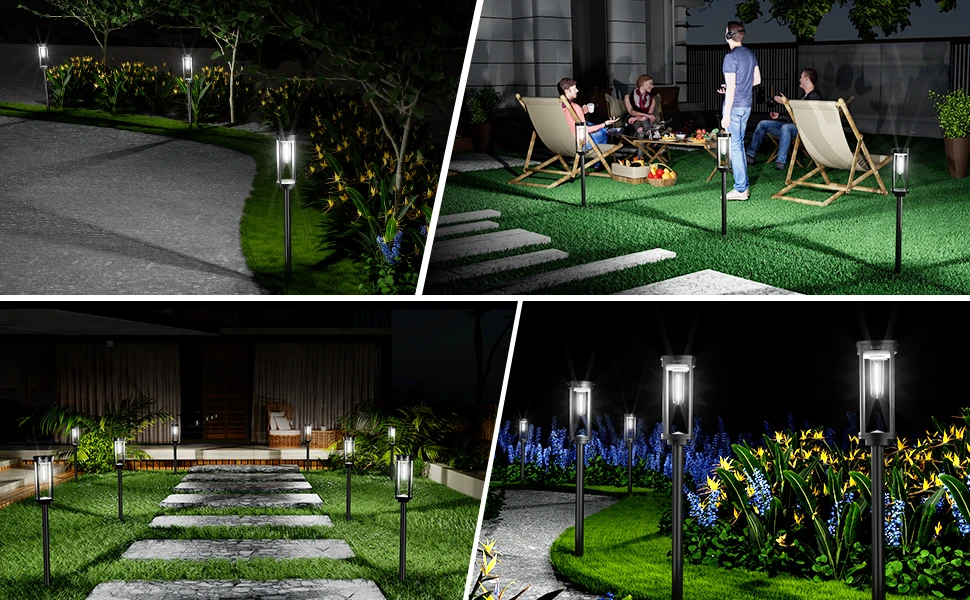North America’s harsh climates—blizzards in the Northeast and hurricanes in the Southeast—challenge solar lighting. Snow blocks photovoltaic panels, halting power, while hurricane winds damage fixtures. These issues disrupt reliability, critical for homeowners needing consistent illumination. Through innovative design, durable materials, and region-specific solutions, manufacturers can ensure solar lights perform in extreme conditions. This article outlines strategies to tackle these challenges, enriched with practical examples.

The Extreme Weather Challenge
Impact of Blizzards and Hurricanes
Northeast blizzards, with 30–50cm snowfalls, cover solar panels, stopping power generation. Southeast hurricanes, with 119–153km/h winds (Category 3–4), can topple or break lights. About 70% of solar light failures in extreme weather stem from snow blockage or structural damage, undermining functionality when lighting is most needed.
Consumer Needs
North American homeowners prioritize reliable lighting for safety and aesthetics during storms. A garden light failing in a blizzard or a fence light blown over by a hurricane erodes trust. Targeted design and technology are key to meeting these demands.
Anti-Snow Solutions
Clearing Photovoltaic Panels
Snow accumulation cripples solar panels. A 30° tilt angle on garden light panels promotes snow slide-off, leveraging gravity based on snow adhesion dynamics. For pathway lights, an electro-thermal snow removal module, activated at -15℃, uses low-power (e.g., 5W) heating elements with temperature and snow sensors to keep panels clear without excessive battery drain.
Energy Efficiency Balance
Heating modules must minimize power use. Smart sensors detecting snow weight optimize energy, maintaining 10–12 hours of runtime. For instance, a heated garden light retains 80% efficiency at -20℃, compared to 30% for standard models.

Wind-Resistant Design
Sturdy Structural Solutions
To endure hurricane winds, courtyard lights need Grade 10 wind-resistant brackets, meeting ASTM D1036 standards for stability at 119–153km/h. Made from reinforced aluminum or stainless steel, these brackets ensure secure anchoring. Fence lights benefit from anti-wind latches, using spring-loaded mechanisms to absorb vibrations and prevent detachment.
Aerodynamic Enhancements
Streamlined lamp bodies with rounded edges reduce wind drag, easing stress on mounts. Wind tunnel testing ensures compliance, vital for Southeast markets like Florida. Such designs enhance durability without compromising aesthetics.
Technical Adaptations
Cold-Weather Battery Performance
In northern regions like Canada or upstate New York, -40℃ temperatures challenge batteries. Low-temperature lithium batteries maintain 85% discharge efficiency at -40℃, using specialized electrolytes, unlike standard batteries that drop to 50% efficiency.
Protective Lens Coatings
For spotlights, hydrophobic anti-snow and anti-fog coatings on lenses prevent ice buildup and ensure clear illumination in blizzards or humid conditions. Silica-based coatings maintain 90% light transmission, critical for safety in low-visibility scenarios.
Implementation Steps
- Battery choice: Select -40℃-rated lithium batteries for cold climates.
- Lens protection: Apply hydrophobic coatings, tested for freeze-thaw durability.
- Smart systems: Use sensors to optimize heating and power management.
Case Study and Regional Insights
New York Suburb Success
In a New York suburb, garden lights with 30° tilted panels and wind-resistant fence lights excelled in a January blizzard. Tilted panels shed snow, ensuring 12-hour runtime, while latched fence lights withstood 100km/h gusts. Pre-deployment testing in -20℃ and windy conditions ensured reliability, earning homeowner approval.
Regional Design Needs
North America’s climates require tailored approaches:
- Northeast (e.g., New York, Ontario): Emphasize snow removal (tilted panels, heating) and low-temperature batteries.
- Southeast (e.g., Florida, Carolinas): Prioritize wind resistance (ASTM D1036 brackets) and anti-corrosion coatings for salty air.
- Midwest: Combine snow and wind solutions with modular designs.
| Region | Climate Challenge | Design Focus |
|---|---|---|
| Northeast | Heavy snow, -40℃ | Tilted panels, heating, low-temp batteries |
| Southeast | Hurricanes, humidity | Wind-resistant brackets, anti-corrosion |
| Midwest | Mixed snow and wind | Modular, balanced features |
Conclusion: Resilient Solar Solutions
Solar lights can conquer North America’s extreme weather with smart design and robust technology. Tilted panels, heating modules, wind-resistant brackets, and low-temperature batteries ensure performance in blizzards and hurricanes. Tailoring solutions to regional climates—snow removal in the Northeast, wind resistance in the Southeast—meets consumer needs for reliability. Manufacturers should assess climate demands, integrate proven technologies, and test rigorously. With these steps, solar lights can illuminate through North America’s toughest storms.

Comments